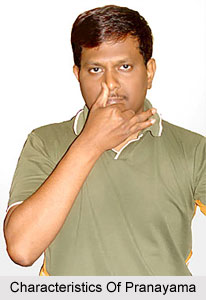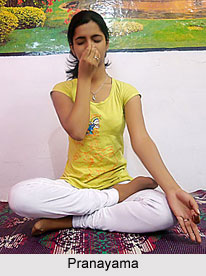 The characteristics of Pranayama primarily pint out that it essentially consists of a voluntary control on the breathing and, probably, due to this fact many people refer it to as a breathing exercise. Various breathing exercises have been developed with the purpose of providing more oxygen to the system. In Pranayama, on the contrary, the emphasis seems to be given on the practice of kumbhaka. The latter refers to a controlled phase of holding the breath.
The characteristics of Pranayama primarily pint out that it essentially consists of a voluntary control on the breathing and, probably, due to this fact many people refer it to as a breathing exercise. Various breathing exercises have been developed with the purpose of providing more oxygen to the system. In Pranayama, on the contrary, the emphasis seems to be given on the practice of kumbhaka. The latter refers to a controlled phase of holding the breath.
Besides these, there are other characteristics of Pranayama which must be kept in mind while practicing it. Pranayama is normally done in a relaxed sitting condition in which the demand for oxygen from the body is minimal. When the haemoglobin is fully saturated with the oxygen, no more quantities of oxygen can be accepted. The human body cannot and does not store oxygen anywhere in the body. During kumbhaka phase more time is available for the exchange of gases between the blood and air. Naturally then, more carbon dioxide is accumulated in the blood and the lungs than that in the normal breathing. If one calculates the amount of oxygen, available in one minute of normal breathing and compare it with the amount of oxygen we are getting in one minute of pranayama it will be clear that the amount of oxygen, available in pranayama, is even less than that of the normal breathing. It is therefore wrong to say that in pranayama one gets more oxygen. Moreover, Practice of pranayama requires a conscious control over the breathing. One remains fully aware of what he is doing during different phases of Pranayama. To put it in other words, Pranayama is never done mechanically. Awareness of breathing is most important while practicing Pranayama. No other bodily action is associated with pranayamic phases.
Talking and singing are also voluntarily controlled respiratory acts but they cannot be compared with Pranayama. Singing or talking involves some kind of emotions or expressions and more over they are the acts of communication. Pranayamic breathing does not produce any emotion nor does it express any thought or desire. Simply holding a breath during underwater swimming is not a kumbhaka as swimming involves some physical and mental activities. During kumbhaka phase a total stand-stillness is necessary, even at the mind-intellect level. That is, while practicing kumbhaka no imagery or thought process is allowed.
Each cycle of Pranayama is a complex voluntary act, consisting of three distinct phases, i.e., puraka, kumbhaka and rechaka.
As far as kumbhakas are concerned there are 3:-
1. Abhyantara or Antar kumbhaka
This is a controlled suspension of breath after Puraka. Since the inhaled air is compressed in the alveoli during this retention, the intra-pulmonary pressure is raised and maintained for some length of time.
2. Bahya or Shunya kumbhaka
It is a controlled retention of breath after rechaka phase. The intra-pulmonary pressure is lowered and maintained for some length of time.
3. Keval Kumbhaka
The suspension of breath appears automatically somewhere in a mid stage of respiratory acts, after a long practice of Pranayama. This stage is characterized by equal atmospheric and intrapulmonary pressure.
Hatha yoga recommends some bandhas to be applied along with each cycle of pranayama. Moola bandha is practiced during puraka, uddiyan bandha is done in rechaka, while in kumbhaka, all the three, i.e., moola, jalandhara and uddiyana bandhas are advocated.
 The following important features are commonly observed whilst practicing all kinds of Pranayama:
The following important features are commonly observed whilst practicing all kinds of Pranayama:
•One has to sit in the pose of any suitable meditative asana, keeping the spine in straight and well-balanced.
•Eyes are closed gently so that at least the powerful external stimulation is cut off. This helps one to pay attention to the inner happenings.
•Inhalation in puraka and exhalation for rechaka is slow, smooth and without any haste. The flow of air is kept uniform having same force all throughout. That means both the phases are gone through in a most controlled way.
•Every puraka and rechaka must end quietly. The habit of expanding the chest or contracting the body musculature violently at the end of puraka and rechaka respectively is consciously avoided. An attempt of snatching the air at the end of puraka and forcing out some more air at the end of rechaka would disturb the next cycle of pranayama. Therefore, puraka and rechaka should end easily, pleasantly and smoothly, without any strain.
•Rechaka is always given longer time than puraka. The orthodox proportion between puraka and rechaka is 1:2. In an effort to give double time for rechaka one should not prolong it too much, which may otherwise hasten the following puraka. Best way is to first judge the duration for which one can prolong the rechaka easily and then to allot just half of the time for puraka.
•An orthodox practice of Pranayama consists of minimum ten rounds at a stretch.
•Moola bandha, jalandhara bandha and uddiyana bandha are applied during kumbhaka. It is a strenuous exercise and one should have a long practice of pranayama before introducing these bandhas in the practice. Only jalandhara bandha may also be employed during kumbhaka and the abdomen may be contracted little inward and maintained in this condition through out the practice of pranayama. This helps one to remain aware of the inner happenings or the breathing, and to prevent the flow of diverting thoughts.
•Increase in the airway resistance is another peculiarity of, pranayama. Inhaling or exhaling through only right or left nostril at a time as in anulom-vilom pranayama or partial closure of glottis to produce sound as in Ujjayi pranayama, reduce the air passage. Naturally, the volume of air reaching the lungs and going out of the lungs will be controlled. The ratio between the volume of air and the volume of blood reaching the lungs will change as the ventilation is approximately reduced to 50 percent.




















